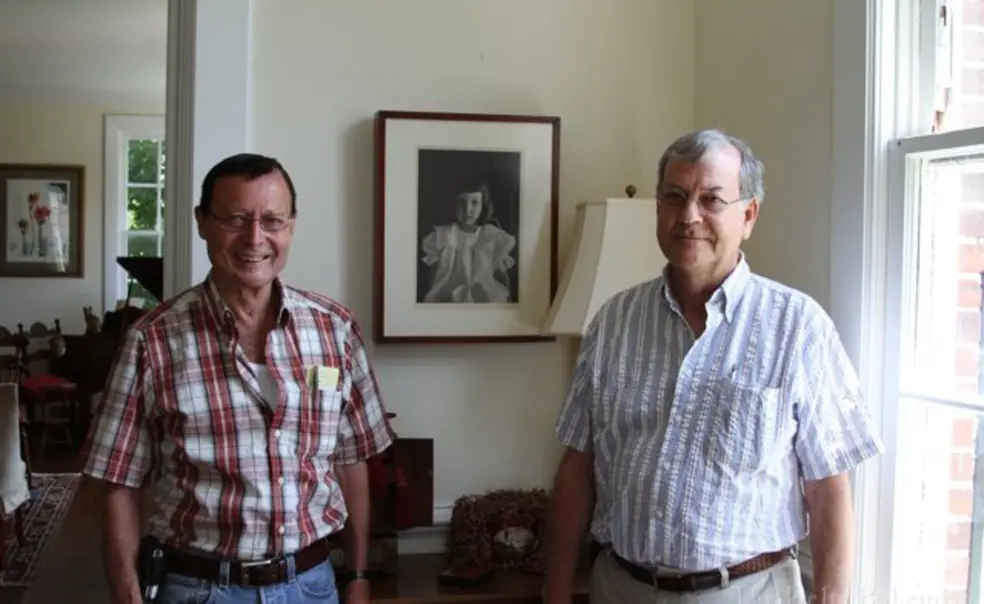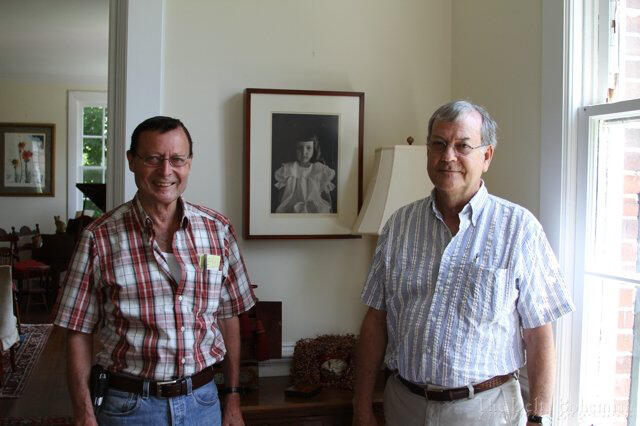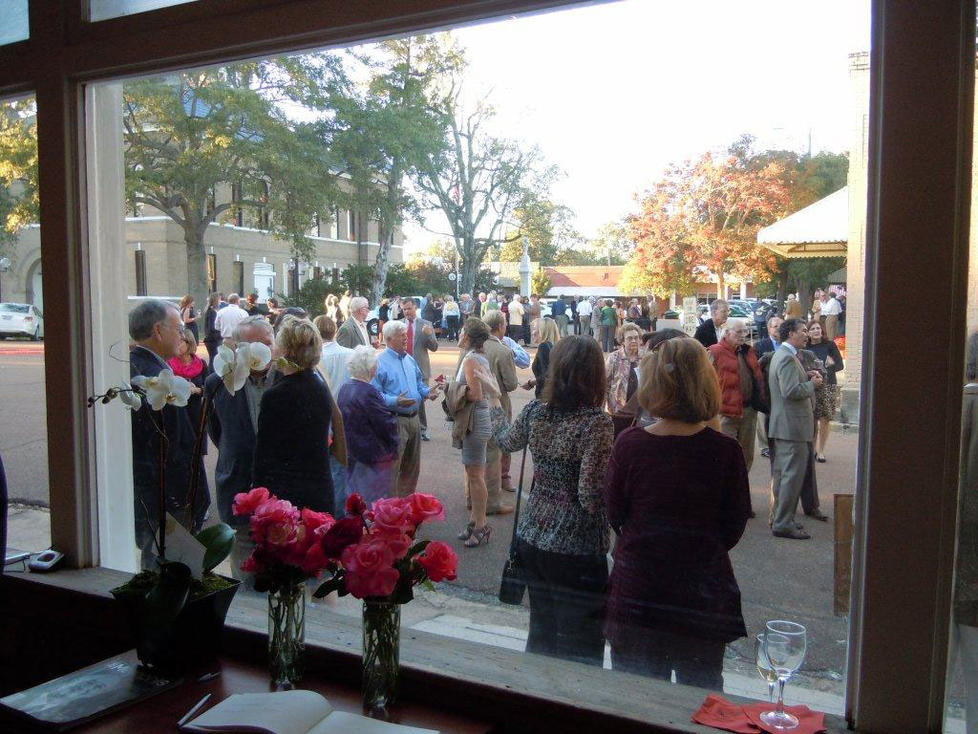Essay - Princeton in the Nation's Service, starting with a village
Two brothers celebrate art and culture in their hometown
Raised in Mississippi and educated at Princeton, my brother Buford Anderson ’62 and I sought after graduation adventures in foreign lands. I joined the Foreign Service and spent my life working in Asia. Buford went to Mexico to seek his fortune in Tampico on Mexico’s Eastern Gulf coast. But returning to our roots, in October 2011 we hosted the opening of the Cassidy Bayou Art Gallery in the sleepy town of Sumner, located in the heart of the Mississippi Delta, in a very personal attempt to help revitalize our hometown.
Despite our wandering, Buford and I never forgot our hometown of Sumner and had fond memories of childhood there. Sumner is a beautiful, well-preserved town that features the world’s longest bayou, the Cassidy, flowing through the town’s center, and the West Tallahatchie County Courthouse, where the infamous Emmett Till murder trial took place in 1955. The somnolent town of 310 people today has no restaurant or grocery store, but the citizens do not want the town to die. Perhaps out of remorse for the events of 1955, as well as to save the courthouse threatened by consolidation with the other half of the county, the town is creating an Emmett Till Museum in the courthouse buildings, and local leaders are working determinedly to achieve economic sustainability.
Impressed by the seriousness with which Sumner’s citizens are attempting to rescue the town, and especially by the museum plans, Buford and I decided to contribute to that effort. We also regarded the project as a tribute to our parents, who established a creative and adventurous environment for our upbringing. We drew both on my work in the 1960s in South Vietnam to help strengthen and make more responsive the provincial Vietnamese government in its contest with the Viet Cong, and on Buford’s struggle to establish a model farm and an excellent school system in Tampico, Mexico. Through our efforts, we hoped to inspire townspeople to imagine roles that they might play in the town’s revival. We decided that an art gallery would be an inspiring contribution to signal a desire to enrich the cultural lives of the young. If we dared such a fanciful project, others might have the faith in the town’s future to address more obvious needs.
We purchased an old family building, dating from the aftermath of a fire in 1909 that destroyed the entire downtown of wooden structures. Built by two relatives on our father’s side, the brick building had been sold to another owner in 1974. I drew up architectural plans, and we began scouting for a local contractor and potential manager. Surviving a process that involved three contractors, we finally renovated the building into the handsome Cassidy Bayou Art Gallery. We also established a symbiotic, nonprofit Cassidy Bayou Art and Culture Foundation, aiming to reach out and enrich through art the lives of the area’s disadvantaged youth, who overwhelmingly come from minority backgrounds. We hope to entice some to pursue art as a career. An artist-in-residence will provide training for local youths in drawing, painting, sculpture, and photography.
The town is extremely appreciative of our efforts. The mayor hailed the project as a significant contribution to the revitalization of the town. One elder described it as “Desaix and Buford’s Marshall Plan for Sumner.” The opening was labeled the most important event in Sumner since the Emmett Till trial. Our goal was to encourage others to pursue similar projects – a grocery store, a restaurant, a cabaret, perhaps rebuilding the landmark Delta Inn, sponsoring tours of Delta plantation homes, catering to duck hunters who flock to the area in the winter months – that could make Sumner an essential stop on Blues Alley and the Civil Rights Trail.
On Oct. 1, the Cassidy Bayou Gallery’s gala opening brought more than 300 friends from abroad and throughout the United States, who came to enjoy Mississippi at its finest: great barbeque, perfect fall weather, and old-style blues by Alphonso Sanders and his son, Keith – not to mention exciting art.
The gallery opened with an exhibition of 1970s photographs by cousin and acclaimed photographer William Eggleston, who also grew up in Sumner, and my acrylic and gold-leaf paintings of Asia, abstractions, and a few whimsical paintings of Sumner. Friends from grammar school, high school, preparatory school, Princeton, and from Buford’s and my foreign worlds gathered in a joyous mood among three buildings, two as cabarets, decorated for the occasion. The evening was magical; life had returned to the town.
The opening of the project and the gallery was a signal success, and Princeton was superbly represented. In addition to Buford and me, Princetonians attending included Hodding Carter ’57; my roommates George Daly ’58 and Jack Perkins ’58; Philip Becton ’60; Chick Reeder ’60; Buford’s roommates Joe Logan ’62, William Cooper ’62, and Judge David Bramlett ’62; Luther Munford ’71; Ken DeCell ’72; Wendy Kuran ’75; and Catherine Clark ’11.
Our efforts in Mississippi followed a trajectory that originated in our inspiration and curiosity about the world that developed at Princeton, where I studied history. After witnessing President John F. Kennedy’s January 1961 inaugural address, I hitchhiked for 10 months throughout Western Europe, taking in the cultural treasure troves. But I was inspired by Kennedy’s famous words, “Ask not what your country can do for you … ,” and joined the Foreign Service for a 40-year career in Asia that culminated in serving as Ambassador Mike Mansfield’s deputy in the U.S. Embassy in Tokyo. I later opened the new U.S. Embassy in Hanoi as Chargé d'Affaires from 1995 to 1997 to seek reconciliation between America and its erstwhile enemy.
Buford, an English major, braved the socialist policies in Mexico in the mid-’60s to become a farmer near Tampico, surviving hurricanes and boll-weevil swarms by introducing the first soybean seed successfully adapted to tropical climes. Later he was named chairman of the board of the second-oldest American School in Mexico, in Tampico; under his leadership, a multimillion-dollar school was built in 1994, sending out students who have become successful citizens in the globalizing world.
The mélange of guests at the October gallery opening provided an unprecedented artistic, cultural, and intellectual ambience in sleepy Sumner, and the event marked a success for Princeton in the nation’s service – at the village level.
Read more about the Cassidy Bayou Art & Culture Center at www.cassidybayou.org.














No responses yet